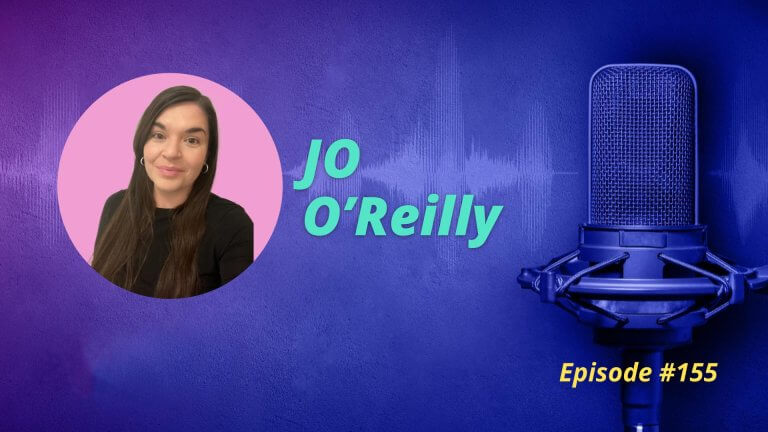In Search Podcast: Newsjacking for Link Building In Three Easy Steps

How do you use newsjacking for link building?
That’s what we’re discussing today with a lady who has a prior career as a journalist, and for the past five years has been working both agency side and in-house as a digital PR manager. A warm welcome to the In Search SEO podcast, Jo O’Reilly.
In this episode, Jo O’Reilly shares three steps for SEO newsjacking, including:
- Get ahead of the news, no crystal ball required
- Know your beat, make context, build medial lists, and keep them updated
- Streamline the process and ensure you can move fast when the news break
Newsjacking for Link Building
Jo: Hi, everyone. I’m really excited to talk about newsjacking. It’s my favorite topic and my favorite thing to do. Hopefully, I can give you some tips to help you get some success with it.
D: You can find Jo over at salience.co.uk. So Jo, how would you define newsjacking?
J: Newsjacking for me is inserting yourself, your brand, or your website into a breaking news story by offering analysis or interpretation of events or just commenting on the news story.
D: So today you’re sharing how to news jack for link building in three easy steps. Starting off with number one, get ahead of the news, no crystal ball is required.
1. Get ahead of the news, no crystal ball required
J: When I tell people that the best thing to do when it comes to newsjacking is not to wait for the news story to break but to get ahead of it, people often look at me like, “Can you tell the future? How do you do this?” And you can. If you’re working in an agency and you’ve got reams of clients it is definitely more difficult. If you’re working with a group of niche clients or if you’re in-house it is incredibly easy when you’re niche down because you can really niche down.
You can get ahead of what we call the news cycle. Wherever you’re based there will be a news cycle. News tends to follow a topical yearly cycle. In the UK at least we’ll always have news about heat waves in the summer or the classic one when I was growing up used to be hosepipe bans to deal with drought. We can predict that these are going to be news stories. If we see on the map, for example, that the weather is heating up, we know that in two weeks’ time, all the news is going to be talking about is the heatwave.
We do love the weather in the UK so that does help. We know that’s going to be a breaking news story, even though it’s going to be a shock to no one. So we can prepare our experts in lawn care if there’s going to be a hosepipe ban or our experts in keeping your car cool, your pet cool, your home cooler, or air conditioning. We can prepare our experts or our in-house thought leaders on these topics that this is going to be a breaking news story that’s prepared for a newsjacket by having comments, data, or whatever else we can provide the journalist ahead of time.
Obviously, there are going to be things that aren’t topical or aren’t part of the news cycle. But there are various things you can do to monitor the media to get ahead of those. Finance is a great example. If you’ve got a finance client, you can sign up in the UK for the Financial Times newsletter, I think you get it around 6 am In the morning so you get the big finance stories of that day.
In America, the one I used to use was Morning Brew, they tend to be really ahead of the finance kind of news in the state. There are ways that you can monitor your patch or your niche to be ahead of the big topics that all the journalists will be writing about that day or that week.
D: You began by talking about cyclical use stories. Is there such a thing as an online resource for common cyclical news stories?
J: You know what, someone should create one. When you’re a journalist, you just know that when Christmas is coming up people will be talking about Christmasy things. It becomes what we call an innate new sense. If you look at the way people work in social media or content marketing, people have content calendars these days, and that tends to be helpful because the rest of us journalists are observing these holidays. Easter is the next big one coming up. We know if we talk about chocolate, we’ll be talking about families getting together. We’ve got Ramadan that’s being observed at the moment around the world so we would have planned for that if we had a client or website in that space. So there are content calendars but there’s not that I know of an online resource. That’s a good idea for someone to take a run with.
D: A good piece of link bait that you can build. Let’s go to step two, know your beat, make context, build media lists, and keep them updated.
2. Know your beat, make context, build media lists, and keep them updated
J: The one thing you don’t want to find yourself doing is if a massive news story breaks in your space, you don’t want to be scrambling around trying to work out who writes about these topics and building the media lists. One of the things we talk about in digital PR an awful lot is about having up-to-date media lists and not spamming journalists that aren’t interested. And trying to do that in a rush because the news just broke. You’ve got around 30 minutes to get a newsjack on someone’s desk.
That’s a very short space of time. You won’t be able to build a media list at that time, it can take me hours to put together a really good media list and I don’t have that time once the store has broken. And once again, if you’re in-house, and you’ve got quite a specific niche, this is much easier, it can just become part of your day-to-day admin keeping that list updated. But definitely take some time to work out who the top journalists are in your niche and have those media lists ready.
A great thing to do when you’re starting out if you don’t come from a media background and you don’t have those contacts is to send an introduction email. Yes, journalists are busy. Yes, we don’t want phone calls or to be taken up to lunch anymore, those days are long gone. But everyone appreciates an introduction email. Say this is who I am. This is the brand and website that I’m working for. Just so we’ve got an expert in finance or insurance or cryptocurrency or whatever it is that this journalist writes about, and say that we’re always available for comment.
If you ever want any analysis, drop us a line. Or ask if they are okay if we add you to our media list for these topics or comments. You might not hear a lot back but you’ve still introduced yourself and the next time you send an email that recognition might do a favor and push you to the top of the pack.
D: I love the idea to send an introduction email because I think many people will be just collating large lists of journalists. And as soon as they get a story, they haven’t made contact with them before, you might go to a spam list, the journalist might not recognize who you are, and they’re much less likely to actually engage with you. So where do you go to build your media list? And how big a list should you seek to create?
J: That’s a very “it depends” question. It’s difficult and you’ll get different answers. And it will depend on your topic as well. Finance is a great example of there being an awful lot of writers in the finance space on both sides of the pond, but people niche down within that space these days. You’ll get people that took that for personal finance all the time. So if you’re sending finance news or corporate finance comments to someone that writes just about personal finance, that’s not really their beat. Just because they’re a finance writer, that’s not something they’re likely to cover or be interested in.
What you want to think about is that niche. Find out what that journalist writes about, and read a couple of their stories. You should be doing that anyway if you’re trying to keep up to date in your space and the news. It is a cliche that journalists receive hundreds of emails, and yes, most of them don’t get looked at. So trying to be as targeted as possible is important. But I’m not one of those PRs who say to only send it to three people because otherwise, it’s spam.
Realistically, you’re not going to have much success if you don’t send your email to as many people as possible that your comment is relevant. It is a numbers game and it would be disingenuous to pretend it isn’t. And the bigger your space, the more you are competing with everyone else.
We’re all trying to get the best coverage and build links with these high-quality news publications. There’s a lot of competition depending on your space and you need to be getting the word out there about who you are and what your expert can speak about.
D: Are you a fan of following your target journalists on social media and commenting on their posts just to try and build that awareness of who you are and what you do?
J: Absolutely. Twitter is the best one for this. Journalists do use Twitter, I used it as a journalist. That’s when I was probably the most prolific of my Twitter career. And it’s just a good way of building connections with people and keeping up to date with what’s going on in your space and niche. We’re all a bit busy and I think sometimes we can be a bit selfish, we only contact journalists when we want something from them.
And anyone I work with, any execs I train, I always say that if you see a journalist that’s put a journal request out on Twitter, for example, and they’re looking for someone but you haven’t got that client, or you can’t help, there’s no harm in saying, “Hey, you know what, I’m not working with anyone. But my colleague is or even a different agency.” That journalist will remember your name, you’ve made contact, and you’ve helped them out. And then one day they will be looking for someone that you are working with, and they’ll remember that this person helped me out. That egalitarian attitude and trying to be helpful for being helpful sake can really help you out further down the line.
And that’s how you build connections these days. We’re not taking journalists up to lunch anymore. It’s not the 80s. That’s not how PRs and journalists behave. But we do try to stay in contact and keep those online relationships that help us out long-term.
D: And step number three is to streamline the process and ensure you can move fast when news breaks.
3. Streamline the process and ensure you can move fast when news breaks
J: Yes. This is a big one. I’m a bit militant with this because I’ve been in a newsroom. I know what it’s like. I know how quickly journalists have to turn these stories around these days. If a news story breaks at 10 am in the morning, and you send a comment out at 3 pm In the afternoon, you’ve missed it. You’ve got probably an hour from when a story breaks, I’d even say half an hour, I try and shorten that process as much as possible.
This is really difficult. I’m not pretending it’s not. And it’s particularly difficult when you’ve got multiple layers of a sign-off process. What I would say smooth that out as quickly as possible. Do dummy runs with your thought leaders and your sign-off process. Practice and see if you can get a personal best by shaving a couple of minutes off each time you practice.
I’ll give you my favorite example of this. There was a big data breach with EasyJet a couple of years back now. I was working for an online privacy company and we had a privacy expert. And I saw the tweet go up about Easyjet and I think I was eating lunch at the time. I was thinking I’ll have to put this sandwich down and come back to this. I think we got it out in 25 minutes and I was pretty happy with that. We got the comment, we got the analysis.
We got it to all the travel journalists, data journalists, and people that covered those kinds of stories. And we landed a huge amount of coverage and links in places that we’d never really worked with before and with journalists we’d never worked with before. We were used to working with Engadget or TechCrunch, or Tech Press, that was our beat. It was a nice place to build quality links that we hadn’t had access to before.
And yeah, it’s great fun as well. It is intense. I love it. It’s one of my favorite parts of the job. It’s like being a journalist again but in reverse. So really exciting. But to have that success, having all those things lined up and that sign-off process smoothed out before a story breaks means that when that buzzer goes, you’ll be straight out the gate. And it is speed that will win, to be the first. Now you’ve got to have a quality comment and you’ve got to have a thought leader that can say something really insightful as well. You can’t just be first if what you’re saying is a bit boring or not really relevant. You can’t have a beautician that responds to a data breach story quickly and have success. You still need your relevance and you still need your quality. But if you can get that quality and that relevance and combine it with being really quick, you’ll have a great time and you’ll achieve huge amounts of success with it.
D: And you said it’s a really nice way to get quality links. How do you optimize the number of links and the quality of links that you get? Do you ask for a link from a journalist? Does a journalist know that’s what you’re looking for?
J: This can be really difficult. I have a really nice line at the bottom of my email. Thank you for using this. We’ll absolutely love and link back and then I add the full URL. And I hope that I’m being polite, I’ve done them a favor, and I hope that they see it, that it landed at their desk at the right time, and that it helped them get their story out within their time limits. I follow up as well if a comment goes live. And the trick with that, and I know other people will say this as well is to be quick about it. Look for that coverage as it rolls in. And if it rolls in and there’s not a link to be quick off the mark to say thanks for using the content, really appreciate it, and we’d love it if you can link it.
We can’t force anyone to link. What I do is earned media. It’s not paid link-building. It’s not a paid media placement. it is a game where you hope that what you provided is enough value that they will provide what you’re asking for back. Be polite, be quick to ask, and be quick to follow up if they’ve used the comment without a link. But there are no guarantees in this game. And that’s part of what makes it the process that it is.
D: I think that was a nice way that you suggest asking. It wasn’t aggressive. It wasn’t a case of you saying we need this or anything like that. You’re thanking them for the opportunity of featuring your content within the publication and then doing the ask after that. And I think you struck the tone nicely there. Obviously, you’ve probably tweaked that with years of experience.
J: Yeah, when I first started doing digital PR I used to work with people that came from a more traditional link-building background. And I have previously been a journalist, and we used to debate this back and forth, how forceful you should be or how polite. When I was a journalist and someone was rude to me, I never worked for them again and you’ve got to strike a very fine balance between being firm and asking directly for what you want, and explaining what you want very clearly and quickly as journalists are busy.
But also you absolutely don’t want to be burning bridges with journalists. Journalists talk to each other. And you should know that journalists move around as much as PRs or SEOs do. I’ve been polite to journalists when they worked for quite small media publications, and as their careers have progressed they’ve ended up in bigger publications, which is great for them, and great for me, because of the contact I’ve kept and the links I was building in perhaps quite a small tech publication three years ago.
Now we’ve got a nice relationship now. So I can be a bit more, not forceful, but I can be a bit more upfront about, “Hey, this is a bit of a give and take, and this is what I need if I do this for you.” So yeah, there is a relationship-building element to it. Don’t go and burn your bridges over one link that you didn’t get, you might get a link next time.
The Pareto Pickle – Build Links with Haro
D: Great advice. Let’s finish off with the Pareto Pickle. Pareto says that you can get 80% of your results from 20% of your efforts. What’s one SEO activity that you would recommend that provides incredible results for modest levels of effort?
J: I’m going to stick with links because links are what I know. I love newsjacking and I like doing PR campaigns, but both take quite a lot of time and quite a lot of expertise. Everyone talks about HARO and you can get an awful lot of great links from there. I think we’ve got several HAROs. I use Quoted and Journalist Request on Twitter. You can spend maybe 10-15 minutes a day browsing through them, finding an opportunity that’s right for you, and putting together some nice, insightful commentary.
I’ve got some really good links this way, just by a lot of responses to HAROs and Journal Requests. It can be a bit forceful and a bit link-building sometimes and journalists don’t like that. But if you’re polite, and you send a really nice email, you can get some really good quality links back from that. And it doesn’t take huge amounts of time or investment. That’s my 20% for 80% idea. Don’t be afraid of tools like HARO or don’t be afraid of contacting journalists, just be polite.
Remember, there’s a human at the end of the email you’re sending. Use it to make friends. I’ve made great contacts and great friends with journalists from things like HARO that have become actual contacts that I now contact outside of those tools. So yeah, that would be my answer.
D: You can find Jo O’Reilly over at salience.co.uk. Jo, thanks so much for being on the In Search SEO podcast.
J: Thank you for having me.
D: And thank you for listening. Check out all the previous episodes and sign up for a free trial of the Similarweb platform over at similarweb.com.
The #1 keyword research tool
Give it a try or talk to our marketing team — don’t worry, it’s free!







